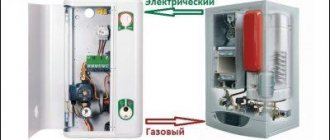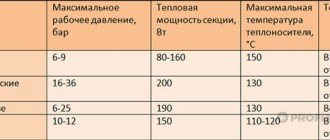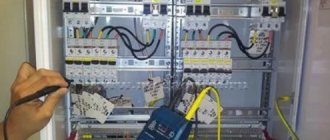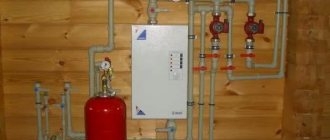However, by and large, this is an advertising trick by marketers, which the majority believed in and, as a result, did not receive any savings.
In reality, these units have obvious disadvantages even at first glance:
- very high price
- large dimensions
- Difficulty in operation when connecting additional equipment (boiler)
Manufacturers loudly advertise their positive qualities, but if you look at them in more detail, even they seem very dubious.
How do advertisers communicate these benefits? They almost always compare it with a heating element boiler. Since they occupy 90% of the electric boiler market.
At the same time, the disadvantages (real or imaginary) for equipment with heating elements are highlighted, and the advantages are given, which are not even close to this in induction ones. Which means they are better.
Let's go over these disadvantages and advantages in more detail.
No heating element
First, the electric boiler is induction, supposedly there are no heating elements. But in a heating element, sometimes there are more than a dozen of them, which means there is a high probability of them breaking, maybe several at once.
But if there were no heating element, then how would the boiler heat the water? The same coil essentially performs this role, only without contact with the liquid. Therefore, this element is present in any such unit.
But as for the high probability of heating elements failing, this directly depends on the product and manufacturer that you buy.
There are specialists who have installed more than 500 heating element boilers over the years of their work, and have not changed a single element under warranty during all this time.
To buy or not to buy an induction heating boiler?
Of course, you yourself must decide for yourself which boiler you should buy: a high-quality heating element or a more bulky, less efficient and expensive induction boiler.
But you must take into account the following: an induction boiler is not a unit for heating systems, especially if they are individual and do not require large capacities. Of course, it is impossible to do without induction heating in some industrial areas of technical production, but this applies to production tasks.
Still, there is no reason to drag a complex, heavy and expensive unit into your home. You can get by with a more elegant solution - a heating element boiler.
Manufacturers of induction heating boilers deliberately provide incomplete information about their products, which misleads those who make a choice in favor of one boiler or another. The important thing here is to tell the truth and show your product from all angles so that people know what they are buying.
Connections and flanges
The second drawback in comparison is the large number of sealing connections (heating elements, flanges) and their complete absence in an induction boiler. Here these advantages and disadvantages can even be swapped.
After all, if the heating element does fail, you can easily replace it. Or simply exclude it from the circuit for a short time, set the jumpers differently and continue working.
But if the coil burns out (due to an interturn short circuit), how much will the repair cost you? And will you be able to keep warm with such a breakdown?
Principle of operation
The fundamental difference between such a stove and other types is that the cookware is heated not by an open flame (as in gas stoves) or a metal heating element (as in conventional electric stoves). Cookware on an induction hob is heated by the movement of electromagnetic currents passing through a magnetic coil under the glass-ceramic surface.
This operating principle allows us to draw the following conclusions.
Only cookware that has ferromagnetic properties will heat up. But this does not mean that you will need to buy something special. The old one may be fine.
How to check if a particular pot or pan is suitable? Bring a magnet to its bottom or look at the symbols. See the picture below for what the “induction” icon looks like.
Use pans with a flat bottom and no dents or bulges.
Only the part of the stove under which the pan is placed will heat up. The glass-ceramic surface of the stove is already heated by hot dishes, and if you remove a hot pan from it, it will quickly cool down in a few seconds. Thanks to this, there is less risk of getting burns (only if from hot dishes during cooking).
This feature of her work is very relevant for families with small children. Even if a child turns on the stove, it will not start to heat up unless there is a pan with a magnetic bottom on it.
Electricity is consumed more economically due to the narrowly targeted effect of heat, and food that gets on the surface does not burn.
The induction oven is easy to clean.
The dishes must be of a suitable diameter - at least 12 cm. This means that an accidentally forgotten fork or spoon on the stove will not heat up. Well, you will have to give up the usual little Turk. Instead, you can buy a special one or purchase an adapter - a metal disk of the diameter required for heating the stove.
Attention! When using an adapter disk, it is not recommended to turn on the equipment at full power. Watch an interesting video about the pros and cons:
Watch an interesting video about the pros and cons:
Water softening and scale
The third point is that with poor water preparation and heavy load, scale forms on the surface of the heating elements. In induction, scale is excluded.
Firstly, the same scale that many people imagine based on the example of a kettle does not exist in heating systems. Because the liquid does not boil there.
But deposits, of course, are always and everywhere. Moreover, in any systems - gas, heating elements, wood, induction, etc.
"scale" in a gas boiler
These are exactly the impurities that are present in water anyway. Pour water into a clean glass, let it evaporate and you will see a thin film on the walls.
Therefore, the presence of an impurity or its absence is not a disadvantage or an advantage, but a given of any heating system.
What to build a boiler from
When designing you will need:
- Plastic pipe as a body part;
- Stainless steel wire as a heating element;
- A piece of copper wire for an inductor;
- Adapters plus ball valves when connecting the boiler to a common system;
- Pliers with wire cutters.
Having prepared everything you need, you can start assembling.
Loosening contacts
Terminal contacts in heating element models, most of them, can be in temperature difference mode. Heating at maximum load, and cooling when switched off.
And this imposes obligations for their revision and tightening.
And in induction, there are supposedly no electrical contacts. In fact, they are always and everywhere, including induction ones.
But as for the former, in recent years specimens with high-quality screw clamps have begun to be produced.
Or there may be screw connections with a locking washer, which do not require maintenance, or spring clamps, which also go without control and revision for years.
In fact, these are just made-up benefits.
Water heaters type VIN
The heart of the unit is a coil consisting of a large number of turns of insulated wire, and placed vertically in a cylindrical housing in the form of a vessel. A metal rod is inserted inside the coil. The housing is hermetically sealed at the top and bottom with welded lids, and the terminals for connection to the electrical network are brought out. Cold coolant enters the vessel through the lower pipe, which fills the entire space inside the body. Water heated to the required temperature goes into the heating system through the upper pipe.
Coolant heating circuit
Due to its design, when connected to the network, the heat generator constantly operates at full power, since it is irrational to supply the heating installation with additional voltage regulation devices. It is much easier to use cyclic heating and use automatic shutdown/on with a water temperature sensor. You just need to set the required temperature on the display of the remote electronic unit and it will heat the coolant to this temperature, turning off the water heating induction element when it is reached. After the time has passed and the water has cooled by a few degrees, the automation will turn on the heating again, this cycle will be repeated constantly.
Since the heat generator winding provides a single-phase connection with a supply voltage of 220 V, induction-type heating units are not produced with high power. The reason is that the current in the circuit is too high (over 50 amperes), it will require laying large cross-section cables, which in itself is very expensive. To increase power, it is enough to put three water heating units in a cascade and use a three-phase connection with a supply voltage of 380 V. Connect a separate phase to each device in the cascade; the photo shows a similar example of the operation of induction heating.
Heating with induction boilers
Design features of heaters of the “Sibtekhnomash” type Using the same effect of electromagnetic induction, another company develops and produces water heating devices of a slightly different design that deserves attention. The fact is that the electric field created by a multi-turn coil has a spatial shape and spreads from it in all directions. If in VIN units the coolant passes inside the coil, then the Sibtekhnomash induction boiler device provides a spiral-shaped heat exchanger located outside the winding, as shown in the figure.
The winding creates an alternating electric field around itself, eddy currents heat the turns of the heat exchanger pipe in which water moves. Coils with coils are assembled in a cascade of 3 pieces and attached to a common frame. Each of them is connected to a separate phase, the supply voltage is 380 V. The Sibtekhnomash design has several advantages:
- induction heaters have a separate, collapsible design;
- in the zone of action of the electric field there is an increased area of the heating surface and a larger amount of water due to the spiral circuit, which increases the heating rate;
- Heat exchanger piping is accessible for cleaning and maintenance.
An example of connecting an induction boiler
Despite the differences in the design of the heat generator, its operating efficiency is 98%, as in heaters of the “VIN” type, this efficiency value is declared by the manufacturer itself. The durability of the units in both cases is determined by the performance of the coils, or more precisely, by the service life of the winding and electrical insulation; manufacturers set this indicator within 30 years.
Replacing the heating element
The service life of heating elements depends on the quality of the coolant. As “comparators” assure, this is only 1000 hours of work, if you do not take action and soften hard water. Well, if they softened it, then about 5000.
When using this data, the heating and water supply systems are confused.
In closed heating systems there are not as many impurities as in water supply. In most cases, water softening is simply not required here.
This may only apply to domestic hot water or central heating. There, the boiler room operator is unable to track water leaks.
If we are talking purely about your home, where everything is assembled and connected without leaks or holes, then no constant water preparation is required. Of course, the water will contain some elements, but once they are poured into the heating system, they will react once or more; they will have nowhere to come from.
Induction ones supposedly have low operating costs due to the very rare replacement of components. In fact, this is in high-quality PETN samples; the elements change extremely rarely, as mentioned above.
But if you need to change something in the induction room, you will think twice before doing it. Everything there is sealed in a sealed flask and you can’t get inside without physically cutting it.
Briefly about the main thing
Induction heating is based on the ability of an alternating magnetic field to increase the temperature of objects made of electrically conductive materials. Heating is carried out in a non-contact manner and is characterized by high performance and low energy losses. For this reason, the method is widely used in various fields - melting, welding, soldering of metals, heat treatment of components and elements in production, disinfection of instruments in medicine.
The same principle applies to the operation of a domestic water heater. The heating element through which the water passes is placed in an inductor coil. When a high-frequency current is applied, an alternating magnetic field is generated, heating the metal heater. Among the main advantages of such devices are:
- Durability.
- Economy.
- No scale.
- Leak-free operation.
- Natural convection.
Disadvantages are associated with the release of heat into the surrounding space, the need for a stable power supply, constant monitoring of performance characteristics, operating noise and harmful radiation. When manufacturing the device, you must follow the instructions and have sufficient experience.
Decrease in electric boiler efficiency
Another argument for comparison is that an induction boiler does not lose its original power during operation. But with heating element, due to scale formation, this happens as a matter of course.
Even sometimes calculations are given, according to which, within just one year, the power of a heating element decreases by 15-20%. This means that its efficiency also decreases.
Let's look at this in more detail.
Almost any electric boiler has an efficiency exceeding 98%. And even boilers operating at ultra-high frequency currents from 25 kHz and above, what can they change for you? Add an extra one and a half percent, but at the same time jump the price by 100%?!
As for deposits on the heating element element, they are indeed present.
In water supply systems in direct heating boilers, a certain “scale” is deposited on the working element. It actually gradually prevents the water from heating up quickly.
What happens where there is no constant supply of impurities? A small layer of deposits may settle on the heating element, however:
- this layer is not thick enough
- it does not in any way interfere with heat transfer
For example, let’s assume that on a clean surface of the heating element, heat transfer occurs at t=60 degrees. As soon as this surface becomes contaminated with deposits, heat exchange will not disappear anywhere, but will begin to occur at high degrees, say 75-80C.
And accordingly, the boiler in no way loses its original efficiency.
That is, in fact, both on a clean heating element and on a dirty one, the same amount of energy is transferred, only at different temperatures.
What do induction heating manufacturers say?
Most often, manufacturers compare induction heating boilers with traditional ones, and traditional ones make up 99% of all electric boilers on the market.
Boilers are always compared according to this scheme: the imaginary shortcomings of heating element boilers and the positive qualities of induction heating at home are highlighted.
For example, the following indicators:
- Quite a lot of heating elements;
- That supposedly one or even several heating elements can fail;
- It is argued that the boiler may lose its working ability;
- They pay special attention to scale, which can appear as deposits directly on the very surface of the heating elements;
- The complexity and bulkiness of the design is due to the fairly large number of electrical contacts;
- The creators of induction boilers claim that their boilers last longer due to the fact that they can soften water;
- An absolutely unfounded and unfounded statement that periodic replacement of gaskets, heating elements and risters is required.
Safety precautions when installing an induction boiler and an energy-saving circuit
There are no safe reactors, energy carriers, or energy generators. The gas is explosive, electricity can injure a person or cause a fire (short circuit). Microwaves have a minimal impact on human health: they activate molecules of liquid substances, disrupting natural processes in the body. A few simple rules will help you avoid even minimal discomfort when using a homemade induction boiler:
- Microwave pulses can be harmful to humans if they remain within 50 cm of an operating device for an extended period of time. If the heat exchanger is installed in the bathroom, turn off the stove during water procedures.
- A mesh (cellular) screen made of magnetic material will help isolate up to 70% of microwave radiation.
- Batteries should not be kept in residential areas or generally inside the apartment. Set up a place on the balcony for this purpose.
Average cost of parts for an energy-saving unit
| Name | Manufacturer | Index | price, rub. |
| Charger 24 V | |||
| NEVATRONIC 24 | Telvin, Italy | 15 A | 5700 |
| ZU1-24-8(5) | SibContact, Russia | 15-18 A | 6300 |
| Fubag SMART 130/24 027985 | Fubag, Germany | 12-25 A | 4800 |
| "SunEnergy" | "SunEnergy", Russia | 12-15 A | 12000 |
| Battery | |||
| Batbear 6ST-190 LA | Alcor, Russia | 190 Ah | 10000 |
| Titan Standard 6ST-190 | Titan, China | 190 Ah | 11000 |
| MUTLU Mega Calcium | MUTLU, Türkiye | 190 Ah | 13900 |
| Mutlu Blue Silver 6CT-190 euro | MUTLU, Türkiye | 250 Ah | 14000 |
| Inverter | |||
| AcmePower AP-DS2000/24 | WMT Limited, China | 2000 W | 13000 |
| AcmePower AP-DS4000/12DC12V/AC | WMT Limited, China | 4000 W | 27500 |
| IS1-24-4000 DC-AC | SibContact, Russia | 4000 W | 48900 |
The heat carrier (agent) “doesn’t care” what it is heated with, but for the owner of the house it is of great importance, and the choice is always made in favor of saving current costs. In the case of induction devices, heating occurs when magnetic waves oscillate. In this case, heat is not transferred from a more heated surface to a less heated one (as in heating elements), but is formed directly in the agent - the liquid. This provides enormous savings on heating.
DIY methods
Thanks to a simple device, you can make a small induction heater yourself.
The easiest way is to install an electromagnet next to the cast iron battery. Home craftsmen also assemble more efficient designs.
From a welding inverter and plastic pipes
This is the most common option.
Proceed in the following order:
- Take a piece of thick-walled plastic pipe DN50 0.5 m long. Most often, a product made of polypropylene is used.
- Using a special heater, weld the coupling on one side, after inserting a circle of metal mesh into it. The part must completely cover the end of the pipe.
- Pour scraps of stainless wire 7 mm thick and up to 5 cm long into the water heater. They will serve as a core.
- Cover the second end of the pipe with a metal mesh and weld the coupling.
- Wind 90 turns of enameled copper wire around the body. This is an inductor coil.
- Connect a 15 A welding inverter with a smooth current control function to the wire.
The device can be made from a welding inverter.
It is permissible to replace couplings with fittings with metal threads.
The heater is ready, you can connect it to the pipeline.
Saving on electricity consumption
Consumption of 2.5 kW instead of 4–5 is an excellent result. But it turned out to be not enough for ambitious and thrifty home craftsmen. But where can I get cheap electricity for the stove? It turns out that the answer has been known for a long time. This device is called an inverter, and it converts direct current into alternating current. With its help, you can reduce current consumption for heating to almost zero.
To reduce energy consumption we need the following:
- Two batteries of at least 190 Ah (preferably 250 Ah).
- 4 kW inverter.
- Battery charger (24 V).
- The main pipes must be made of non-magnetic material (plastic, aluminum, copper).
We connect the batteries in parallel and put them on constant “charging”. The process that occurs in an electrical circuit:
- The batteries generate direct current, which is supplied to the inverter.
- The inverter converts direct current into alternating current 220 V.
- Current from the inverter is supplied to the induction furnace, which operates in normal mode (flow).
- The charger continuously recharges the batteries.
Thus, heating the apartment costs the consumption of a 24-volt charger, not counting the cost of operating the circulation pump, which will be used in any option.
Main types
Different types of boilers differ in the design of the heat exchanger:
- Casing. The device consists of 2 parts located inside and outside the coil.
- Volumetric or inductive-conductive. The boiler tank is located inside the winding and contains a ferrite core.
- Tubular. The first induction heaters belonged to this type. The heat exchanger is a set of pipes that go around the winding.
The units are also divided into models with and without an inverter.
Improving the heat exchanger
Of course, a theoretical saucepan is only an intermediate version of a heat exchanger. In practice, it must be reliable, cheap and compact, because we are talking about heating an apartment (small area - up to 50 sq. m). The amount of agent should not exceed 40 liters. A flat metal tank with dimensions of approximately 500x600x50 mm is most suitable for all of the above requirements. Such a container can be welded from a 50x50 profile pipe.
- Cut the pipe 50x50 to 600 mm - only 9-10 pieces.
- Weld the sections together wall to wall to form a row of tubes.
- Cut a length of transverse length lengthwise and remove one wall from the pipe.
- Install and weld the transverse section in the manner of a comb manifold.
- Install the opposite wall in the same way.
- Weld 1-1.5 inches of fittings into diagonally opposite planes.
- Carefully scald the structure - it must be airtight and all chambers must communicate freely.











